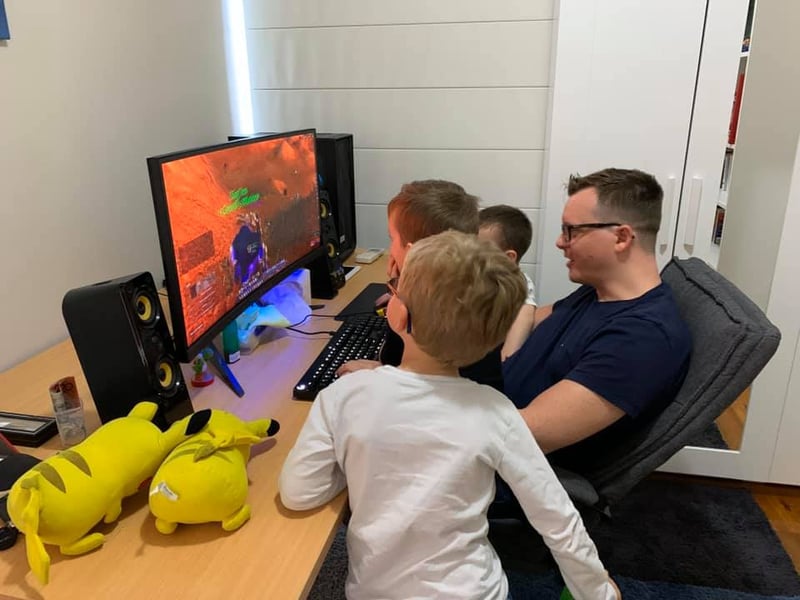
James, how long have you been with OSIT?
A mere 13 years!
13! Wow. Can you cast your mind back 13 years and a day, what where you doing before you joined OSIT?
I was in a similar job to when I started at OSIT. I was working for a small IT Managed Services Provider. I started looking for a bit more of a challenge when I felt like I had mastered the role I was in.
Office Solutions IT was ‘big’ at the time – they had 12 people, which when compared to the team of 2 I was in, seemed like a big organisation that could offer me a few more career pathways than my current position. I figured they would have bigger clients and opportunities to push myself in a larger team
What did your role involve when you first joined OSIT?
I was really excited to start! I was what we called a Systems Engineer at the time – which has sort of morphed into the modern-day support engineers we have now. So, I started as a System Engineer – and there was no structure back in those days. It was a ‘good-luck’ approach whereby ‘it was my job is to just do IT for these 16 clients’.
There was no induction, no training. It was a case of ‘here’s your password, now login to the system and go for it!’. I’ll never forget my second day.. I met a client for the very first time and their server went down. Their whole site was out and I didn’t even know the password! Oh, and it was my responsibility to fix it! It’s safe to say things have improved a lot since!
Let’s fast forward 13 years down the track, how has your role and career developed today?
Quite a bit to be honest!
I’m a bit of a sponge for learning stuff that I’m interested in. I got pretty good at that system engineer role, I really enjoyed it. I kept at it for about 4 years before I started feeling like I needed a new challenge again. So, I spoke about that with James Sutherland at the time and he offered me a whole new challenge, which was to come on board as a director of the company!
So that was a big jump and not long after I was the Technical Director of Office Solutions IT. This role meant that I got to help other team members and make a big difference to what we were doing and how we delivered our service – especially around the technical aspects.
Back then, the solutions we rolled out were heavily dependent on the Systems Engineers’ personal preferences. Some liked Acer servers, others preferred HP and so on. There was no consistency, every engineer just did whatever they wanted. Some did pro-active maintenance; some didn’t, it was all very much a case of one rule for one and another for someone else.
There was a lack of consistency and a lack of professionalism in a way. And it was all a bit messy, so I wanted to improve that.
We’d also find ourselves in the situation where an engineer would leave to move onto another firm and the Engineer we’d employ as the replacement had a tough time getting to learn all of the different technologies for each client and ultimately we’d lose customers because of it.
It became a familiar pattern, as soon as we lost an engineer, we would lose a customer. And it meant that we couldn’t scale our business, we had no growth and it just felt like we were spinning our wheels, so I viewed that as a challenge to overcome.
It wasn’t easy. We created new processes, standards and technical check-lists to improve consistency. Some people embraced the change, others actively resisted it. And I learned a lot about people – which I hadn’t really been exposed to before. It took a few years, and I became convinced that this model was the way to go. And over time we became a little more systemised in how we did things and it made a huge difference.
What does a typical day to day look like today?
Today, my role has shifted from Technical director to Managing Director and there’s not a whole deal of consistency. Sure, I have regular meetings with the team members locked in each week/month. But sometimes It can be reactive because something has gone awry, so I help provide support where I can. Most of my time is spent on the long-term-strategy, growth and direction of Office Solutions IT - AKA the stuff that we’re doing now that will change the way our internal and external services are delivered in six months’ time.
What does the future of OSIT look like?
Glorious! We will get to a point where we’re able to help develop our people and our clients more and more. It’s something I am really excited about and we’re already starting to see it happen. We’re running training sessions on a weekly basis now for example. I’ve wanted to make that happen for years and we’ve started it this year. It’s a really exciting space to occupy. As we get bigger, we’re able to invest more into our team, in our systems and how we run – it’s exciting – I very much enjoy improving things and not just systems and process, but careers and people too.
Let’s talk growth, you’ve obviously levelled up your role to the max and you make a point of helping others to do the same, why is it so important to you?
There’s a huge personal element to this. I want to give people the same opportunities that I had. I am really grateful for the opportunities, and I never thought I would be the MD of a rapidly growing IT MSP – I wasn’t one of those people that had their career all mapped out in high school. So I’d like to pay it forward where I can and always treat people how I’d like to be treated. And that extends to giving people the same opportunities that I recieved – we’re serious about promoting from within, personal growth and our new training academy – it was done for me and I really want to be able to do that for people as well. It’s just the right thing to do.
You mentioned the training academy, what’s the deal with that?
Well, anyone can read a book or watch a video that shows them how to do something, like setup a complex system or even something like a site to site VPN. But nothing really replicates the real-life scenario of actually doing it, troubleshooting it and making it work. It’s so much more fun, interesting and engaging, than a book or watching a video. So, we have setup a lab environment for our Engineers to get hands on with new technology, so they can actually learn stuff and build up their experience in a real world scenario.
Do you have a mentor or role model? And if so, what’s the best piece of advice you’ve received from them?
Yes, I do have a mentor outside of the business. I think it’s helpful to have an external 3rd party that can provide some unbiased prospective on stuff. Ah geez! The single best bit of advice!? That’s really difficult, because he gives a lot of great advice!
I would say it’s about listening. Specifically, about trying to understand where people are coming from in any given scenario.
I think that was (and still is) very good advice for me because, to be honest, I am a Mr Fix-it.
I like fixing things really quickly and I’m really good at it. But I’m the first to admit that this approach can cause problems.
My default approach is to spit out the answer to a problem like I’m a contestant on a game show, but sometimes just listening is all that’s required. And by doing so, you get a more complete understanding of whatever the issue is. Sometimes people just need to offload or talk and feel like they’ve been heard – which is really important. So, it’s equally important for me to respect that and turn Mr Fix-It mode off.
What does a Monday morning feel like for you?
I’m excited. I have a routine Monday morning meeting at 9am to discuss the bigger projects that we are working on for that quarter – again, occupying that future focused role. We get to discuss the goings on with the key people of the team, and I’m usually quite energised by that meeting - it’s all about how we are making things better for both our team members and our customers.
If there was one person that could give an insider tip to help applicants to get their foot in the door at Office Solutions IT it’s got to be the MD! So, what’s your best tip for our new applicants?
It’s all about your learning and growth mindset.
No one knows everything. And it’s not expected that you should know all the answers to every problem and technology. We get that and understand that.
The people who are excited about learning and discovering something new – the people whose eyes light up when we talk about getting involved with new technology and show their passion – the people who get a kick out of the joy of learning and growing, these are the people that we are constantly trying to surround ourselves with.
And how would you suggest that candidates convey that learning and growth mindset?
Well we often ask questions about what technology candidates are currently playing around with, like their home IT lab, or advanced systems, settings or problems that they’ve solved. And what we’re usually looking for there is genuine excitement and passion about the industry we’re in and obviously the technology. Those are the people we’re interested in and those are the people that do really well here at Office Solutions IT.
It’s not necessarily all about the skills you have right now. If we can see genuine passion for learning, we’ll take a chance and provide all the support and opportunities to grow.
Great management…
Nah, I’ll give you a real one. The biggest thing I love about working here is the people. The people by far. They are so friendly, so helpful, there’s always laughter echoing around the place. It’s just a great, fun, supportive atmosphere and it’s awesome to turn up each day and work with these people.










